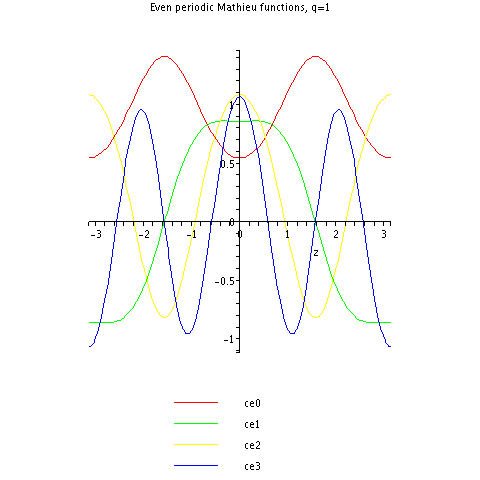Physics:Quantum pendulum
The quantum pendulum is fundamental in understanding hindered internal rotations in chemistry, quantum features of scattering atoms, as well as numerous other quantum phenomena. Though a pendulum not subject to the small-angle approximation has an inherent nonlinearity, the Schrödinger equation for the quantized system can be solved relatively easily.
Schrödinger equation
Using Lagrangian mechanics from classical mechanics, one can develop a Hamiltonian for the system. A simple pendulum has one generalized coordinate (the angular displacement [math]\displaystyle{ \phi }[/math]) and two constraints (the length of the string and the plane of motion). The kinetic and potential energies of the system can be found to be
- [math]\displaystyle{ T = \frac{1}{2} m l^2 \dot{\phi}^2, }[/math]
- [math]\displaystyle{ U = mgl (1 - \cos\phi). }[/math]
This results in the Hamiltonian
- [math]\displaystyle{ \hat{H} = \frac{\hat{p}^2}{2 m l^2} + mgl (1 - \cos\phi). }[/math]
The time-dependent Schrödinger equation for the system is
- [math]\displaystyle{ i \hbar \frac{d\Psi}{dt} = -\frac{\hbar^2}{2 m l^2} \frac{d^2 \Psi}{d \phi^2} + mgl (1 - \cos\phi) \Psi. }[/math]
One must solve the time-independent Schrödinger equation to find the energy levels and corresponding eigenstates. This is best accomplished by changing the independent variable as follows:
- [math]\displaystyle{ \eta = \phi + \pi, }[/math]
- [math]\displaystyle{ \Psi = \psi e^{-iEt/\hbar}, }[/math]
- [math]\displaystyle{ E \psi = -\frac{\hbar^2}{2 m l^2} \frac{d^2 \psi}{d \eta^2} + mgl (1 + \cos\eta) \psi. }[/math]
This is simply Mathieu's differential equation
- [math]\displaystyle{ \frac{d^2 \psi}{d \eta^2} + \left(\frac{2 m E l^2}{\hbar^2} - \frac{2 m^2 g l^3}{\hbar^2} - \frac{2 m^2 g l^3}{\hbar^2} \cos\eta\right) \psi = 0, }[/math]
whose solutions are Mathieu functions.
Solutions
Energies
Given [math]\displaystyle{ q }[/math], for countably many special values of [math]\displaystyle{ a }[/math], called characteristic values, the Mathieu equation admits solutions that are periodic with period [math]\displaystyle{ 2\pi }[/math]. The characteristic values of the Mathieu cosine, sine functions respectively are written [math]\displaystyle{ a_n(q), b_n(q) }[/math], where [math]\displaystyle{ n }[/math] is a natural number. The periodic special cases of the Mathieu cosine and sine functions are often written [math]\displaystyle{ CE(n,q,x), SE(n,q,x) }[/math] respectively, although they are traditionally given a different normalization (namely, that their [math]\displaystyle{ L^2 }[/math]norm equals [math]\displaystyle{ \pi }[/math]).
The boundary conditions in the quantum pendulum imply that [math]\displaystyle{ a_n(q), b_n(q) }[/math] are as follows for a given [math]\displaystyle{ q }[/math]:
- [math]\displaystyle{ \frac{d^2 \psi}{d \eta^2} + \left(\frac{2 m E l^2}{\hbar^2} - \frac{2 m^2 g l^3}{\hbar^2} - \frac{2 m^2 g l^3}{\hbar^2} \cos\eta\right) \psi = 0, }[/math]
- [math]\displaystyle{ a_n(q), b_n(q) = \frac{2 m E l^2}{\hbar^2} - \frac{2 m^2 g l^3}{\hbar^2}. }[/math]
The energies of the system, [math]\displaystyle{ E = m g l + \frac{\hbar^2 a_n(q), b_n(q)}{2 m l^2} }[/math] for even/odd solutions respectively, are quantized based on the characteristic values found by solving the Mathieu equation.
The effective potential depth can be defined as
- [math]\displaystyle{ q = \frac{m^2 g l^3}{\hbar^2}. }[/math]
A deep potential yields the dynamics of a particle in an independent potential. In contrast, in a shallow potential, Bloch waves, as well as quantum tunneling, become of importance.
General solution
The general solution of the above differential equation for a given value of a and q is a set of linearly independent Mathieu cosines and Mathieu sines, which are even and odd solutions respectively. In general, the Mathieu functions are aperiodic; however, for characteristic values of [math]\displaystyle{ a_n(q), b_n(q) }[/math], the Mathieu cosine and sine become periodic with a period of [math]\displaystyle{ 2\pi }[/math].
Eigenstates
For positive values of q, the following is true:
- [math]\displaystyle{ C(a_n(q), q, x) = \frac{CE(n, q, x)}{CE(n, q, 0)}, }[/math]
- [math]\displaystyle{ S(b_n(q), q, x) = \frac{SE(n, q, x)}{SE'(n, q, 0)}. }[/math]
Here are the first few periodic Mathieu cosine functions for [math]\displaystyle{ q = 1 }[/math].
Note that, for example, [math]\displaystyle{ CE(1, 1, x) }[/math] (green) resembles a cosine function, but with flatter hills and shallower valleys.
See also
Bibliography
- Bransden, B. H.; Joachain, C. J. (2000). Quantum mechanics (2nd ed.). Essex: Pearson Education. ISBN 0-582-35691-1.
- Davies, John H. (2006). The Physics of Low-Dimensional Semiconductors: An Introduction (6th reprint ed.). Cambridge University Press. ISBN 0-521-48491-X.
- Griffiths, David J. (2004). Introduction to Quantum Mechanics (2nd ed.). Prentice Hall. ISBN 0-13-111892-7.
- Muhammad Ayub, Atom Optics Quantum Pendulum, 2011, Islamabad, Pakistan., https://arxiv.org/abs/1012.6011
 |


